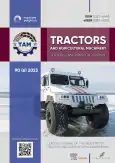Control laws for individual traction electric drive of a front loader
- Authors: Gartfelder V.A.1, Stadukhin A.A.2, Mokretsov N.A.2
-
Affiliations:
- Chuvash State University named after I.N. Ulyanov
- Bauman Moscow State Technical University
- Issue: Vol 90, No 6 (2023)
- Pages: 531-541
- Section: Theory, designing, testing
- URL: https://journals.rcsi.science/0321-4443/article/view/253587
- DOI: https://doi.org/10.17816/0321-4443-569416
- ID: 253587
Cite item
Full Text
Abstract
BACKGROUND: The operation of technological machinery is associated with regular slipping of driving wheels, which can lead to increased tire wear and soil damage. This determines the relevance of works aimed at study and reduction of slip.
AIM: Analysis of the considered control strategies of individual traction electric drive of a front loader with regard to driving wheels slipping.
METHODS: The paper considers three control strategies of individual traction electric drive of a front loader — initial, with equal utilization rates of electric motor-wheels (strategy 1), simulation of locked drive (strategy 2), and the proposed option of building traction control system (strategy 3). Using a simulation computer model of dynamics, the working process of the front loader was studied during earthmoving operations and when accelerating.
RESULTS: It was obtained that the application of the strategy 2 during earthmoving helps to ensure almost the equal slip coefficient of the driving wheels, which potentially helps to reduce tire wear and fuel consumption (in comparison to the strategy 1). The application of the strategy 3 in such conditions turned out to be unsuitable, as the slip limitation in this case reduces the operation speed as well. The simulation of the front loader acceleration process showed some advantage of strategy 3 over the others in terms of energy consumed.
CONCLUSIONS: According to the results of the study, it is reasonable to use the control strategy 2, which simulates a locked transmission, in case of performing heavy technological operations by a front loader such as earthmoving. In the case of the acceleration process, typical for transportation operations and driving on public roads, it is effective to use the strategy 3.
Full Text
##article.viewOnOriginalSite##About the authors
Victor A. Gartfelder
Chuvash State University named after I.N. Ulyanov
Email: harvik48@list.ru
ORCID iD: 0000-0002-6759-6756
SPIN-code: 6075-0549
Cand. Sci. (Engineering), Dean of the Mechanical Engineering Faculty
Russian Federation, CheboksaryAnton A. Stadukhin
Bauman Moscow State Technical University
Email: ant.m@bmstu.ru
ORCID iD: 0000-0003-1414-3435
SPIN-code: 7669-7133
Dr. Sci. (Engineering), Associate Professor of the Multipurpose Tracked Vehicles and Mobile Robots Department
Russian Federation, MoscowNikolay A. Mokretsov
Bauman Moscow State Technical University
Author for correspondence.
Email: mnasm@bmstu.ru
ORCID iD: 0000-0002-7050-1914
SPIN-code: 4916-9707
Dr. Sci. (Engineering), Associate Professor of the Multipurpose Tracked Vehicles and Mobile Robots Department
Russian Federation, MoscowReferences
- Gorelov VA, Kositsyn BB, Stadukhin AA, et al. Method for determining the parameters of the front loader electromechanical transmission. Tractors and Agricultural Machinery. 2021;88(5):38-45. (In Russ). doi: 10.31992/0321-4443-2021-5-38-45
- Byakov KE, Stadukhin AA, Mokretsov NA. Comparative assessment of the fuel efficiency of a front loader. Transportnye sistemy. 2022;4(26):51–62. (In Russ). doi: 10.46960/2782-5477_2022_4_51
- Devyanin SN, Bizhaev AV. Analysis of slipping of the tractor drive wheel under the influence of a complex factor. In: Readings of Academician VN Boltinsky: seminar, Moscow, January 20–21, 2021. Moscow: OOO “Sam Poligrafist”, 2021:300–306. (In Russ).
- Levshin AG, Gasparyan IN, Alsankari A, et al. Methodology for express analysis of slippage in tractor operating modes. Agroinzheneriya. 2022;24(4):32–36. (In Russ). doi: 10.26897/2687-1149-2022-4-32-36
- Heubaum M, Münch Ph, Costantini G, et al. Slip Detection and Control for Harvesting Machines. IFAC-PapersOnLine. 2022;55(32):18–23. doi: 10.1016/j.ifacol.2022.11.108
- Chudakov O.I. Analysis of operating conditions for front-end loaders and synthesis of design load modes. In: INTERSTROYMEH-2022. Materials of the XXVI International Scientific and Technical Conference. Yaroslavl; 2022:134–142. (In Russ).
Supplementary files

















